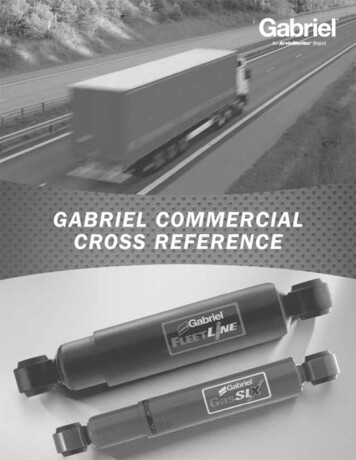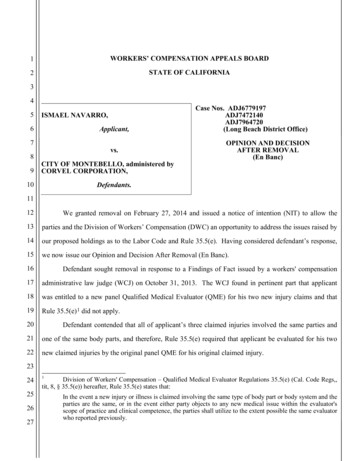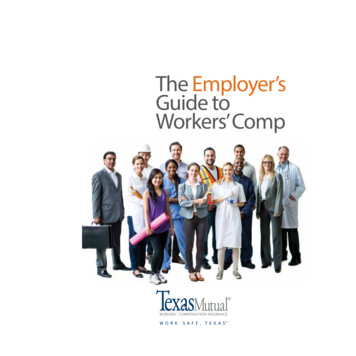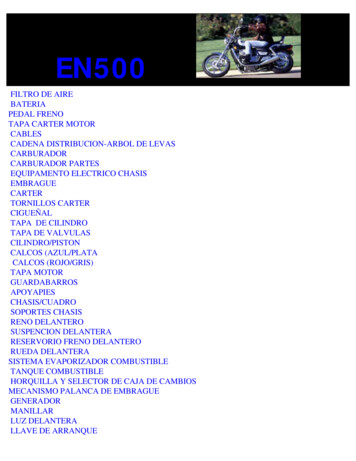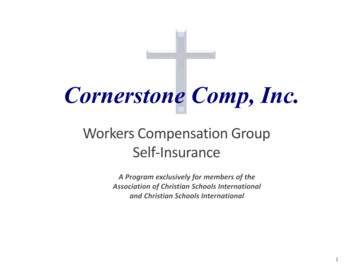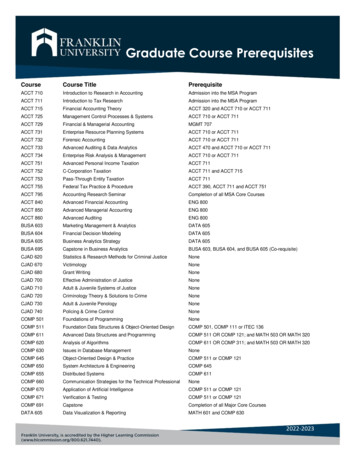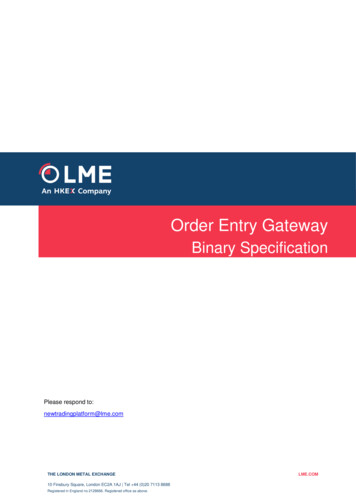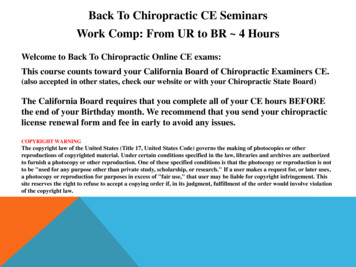
Transcription
Back To Chiropractic CE SeminarsWork Comp: From UR to BR 4 HoursWelcome to Back To Chiropractic Online CE exams:This course counts toward your California Board of Chiropractic Examiners CE.(also accepted in other states, check our website or with your Chiropractic State Board)The California Board requires that you complete all of your CE hours BEFOREthe end of your Birthday month. We recommend that you send your chiropracticlicense renewal form and fee in early to avoid any issues.COPYRIGHT WARNINGThe copyright law of the United States (Title 17, United States Code) governs the making of photocopies or otherreproductions of copyrighted material. Under certain conditions specified in the law, libraries and archives are authorizedto furnish a photocopy or other reproduction. One of these specified conditions is that the photocopy or reproduction is notto be "used for any purpose other than private study, scholarship, or research." If a user makes a request for, or later uses,a photocopy or reproduction for purposes in excess of "fair use," that user may be liable for copyright infringement. Thissite reserves the right to refuse to accept a copying order if, in its judgment, fulfillment of the order would involve violationof the copyright law.
Exam Process: Please read all instructions before starting!1. You must register/pay first. If you haven't, please return to: backtochiropractic.net2. Open a new window or a new internet tab & drag it so it's side-by-side next to this page.3. On the new window or new tab you just opened, go to: backtochiropractic.net website.4. Go directly to the Online section. DON'T register again.5. Click on the Exam for the course you want to take. No passwords needed.6. Follow the Exam instructions.7. Upon passing the exam you’ll be able to immediately download your certificate,and it’ll also be emailed to you. If you don’t pass, you can repeat the exam at no charge.Please retain the certificate for 4 years.If you get audited and lose your records, I’ll have a copy.I’m always a phone call away. 707.972.0047 or email: marcusstrutzdc@gmail.comMarcus Strutz, DCBack To Chiropractic CE Seminars
GLENN CRAFTS, B.S., D.C., Q.M.E.UTILIZATION REVIEW DIRECTORPRIVATE PRACTICETel: (408) 691-4012 Email: drcrafts@sbcglobal.net 2015 Copyright - ALL RIGHTS RESERVEDDo Not Duplicate or Distribute without written permission
Types of Review Prospective Review: Conducted prior to the delivery of health care services Concurrent Review: Conducted when the patient is receiving the health care services orduring hospitalization Retrospective Review: Conducted after the patient has received the health care services Extension Review: When additional information is requested on either a prospective orconcurrent RFA Reconsideration Review: Conducted if the additional information requested by the URO isreceived after a decision was already made Expedited Review: Conducted if there is a serious and imminent threat to the health of theinjured worker, and must be certified Appeal Review: Conducted after an adverse UR decision by a different physician reviewer whomust be board certified and in the appropriate scope of practice Peer to Peer Review: Conducted after an adverse UR decision by the same physician reviewer
UR Required Decision Timeframes
What is Day 0? Every provider requesting treatment must know when the decision is due.The majority of providers ask for treatment prospectively (i.e.before they render care).The initial day either the claims administrator or the UtilizationReview Organization (URO) receive your Request forAuthorization (RFA) is counted as Day 0 (zero).The decision is due within 5 business days unless a Request forAdditional Information (RFI) is sent, which would extend thedue date to the 14th calendar day.In the calendar example for November that follows, Day 0 isFriday the 4th, and absent an RFI, would be due on Monday the14th (or the 5th business day after Veteran’s day holiday.)
turday5ProspectiveREQUESTRECEIVEDCOUNTEDAS DAY ectivedue if noaddl. Info.requested20212223272829303
California Treatment Guidelines MTUS - http://www.dir.ca.gov/dwc/DWCPropRegs/MTUS/MTUS Regulations.htm ACOEM – 2004, 2nd edition Official Disability Guidelines California’s workers’ compensation is highly regulated, and requires allrequests for medical treatment go through (UR) Utilization Review (ifthe claims administrator will not immediately authorize thetreatment). Treatment requests are only approved in UR if it meets the definitionof Medical Necessity, which is determined by the mandated treatmentguidelines above. The burden to prove medical necessity always remains with theapplicant. In other words, the requesting provider must clearlysubstantiate the medical necessity within their Request forAuthorization (RFA).
Guidelines
What is an RFA? RFA Request for Authorization Providers in workers’ compensation must request for treatment authorization in 1 of 3 ways:DFR (Doctor’s First Report)/5021PR-2 (Progress Report)Narrative RFAThe DFR & PR-2 are both standardized forms found atthe DWC’s website for download.
Chiropractic Guidelines by Body Part Neck Pain (ODG) states 9 visits over 8 weeks. Cervical Strain (ODG) states (Grade I) 6 visits over 3 weeks; (Grade II) 6 visits over 3 weeks; (Grade III) 10 visits over 6weeks; (Severe Grade III) Up to 25 visits over 6 months.Cervical Radiculopathy (ODG) states 6 visits over 3 weeks;with functional improvement 18 visits over 8 weeks.Cervical/Post Laminectomy (ODG) states 14-16 visits over 12weeks.Low Back (ODG) states (Mild) 6 visits over 2 weeks; (Severe) 6 visits over 2 weeks; (Severe w/objective/functionalimprovement) 18 visits over 8 weeks.Low Back (Flare-Ups) 1-2 visits every 4-6 months.Hip (ODG) states up to 10 visits.
Functional Improvement Physical Impairments (e.g., joint ROM, muscle flexibility, strength,or endurance deficits): Include objective measures of clinical examfindings. ROM should be in documented in degrees. Approach to Self-Care and Education Reduced Reliance on OtherTreatments, Modalities, or Medications: This includes the provider'sassessment of the patient compliance with a home program andmotivation. The provider should also indicate a progression of carewith increased active interventions (vs. passive interventions) andreduction in frequency of treatment over course of care. (California,2007) For chronic pain, also consider return to normal quality of life, e.g.,go to work/volunteer each day; normal daily activities each day; have asocial life outside of work; take an active part in family life. (Cowan,2008)
Qualifications of Personnel No person, other than a licensed physician who is competent toevaluate the specific clinical issues involved in the medical treatmentservices, and where these services are within the licensure and scope ofthe physician’s practice, can delay, modify or deny, requests forauthorization (RFAs) of medical treatment for reasons of medicalnecessity to cure or relieve the effects of the industrial injury.
The UR Determination A Utilization Review determination communication by telephoneshall be followed by written notice to the physician, the injuredworker, and if the injured worker is represented by counsel, the injuredworker’s attorney within 24 hours for concurrent review and within twobusiness days for prospective review. 5:30 PST End of Business Day (M-F)
DWC Form RFADocumenting an Incomplete DWC form RFA: DWC Form RFA that: does not identify the employee or provider, does not identify a recommended treatment, is not accompanied by documentation (i.e. DFR, PR-2, RFA Narrative) substantiating themedical necessity for the requested treatment, or is not signed by the requesting physician,
Complete the DWCForm RFA and attachto your treatmentrequest every time.
Independent Bill ReviewIBR Fees ( ) Any IBR application submitted on or after January 1, 2015 will be subject to the following feeschedule: Completed IBRFee effective April 1, 2014: 250 per IBRFee effective Jan. 1, 2015: 195 per IBR Ineligible IBR Not Sent to Review***Fee effective April 1, 2014: 50.00 per IBRFee effective Jan. 1, 2015: 47.50 per IBR *** Sending an IBR to review means assigning and providing the complete file to a certifiedcoding specialist with the expertise necessary to evaluate and render decisions on all lineitems in dispute.
Independent Bill ReviewIBR Application In order to contest a non-payment for treatment, the provider must first request for a 2nd Bill Review.The 2nd Bill Review does not cost anything for the provider to contest.If payment is still disputed after the outcome of the 2nd Bill Review,then the provider may submit the application for IBR.The provider does pay a fee for IBR.The following slide contains the IBR application form that must becompleted and submitted with your documentation explaining whypayment should be made.Refer to the prior slide for the IBR algorithm.
SB863 vs. Duplicate RFAs UR determinations that modify, delay, or deny treatment recommendations areconsidered valid for 12 months absent any documented change in factsmaterial to the basis of the utilization review decision. This will eliminate needless UR on duplicate RFAs. Same treatment requests from a different requesting provider will not beconsidered duplicative and are subject to UR based on unique and differentmedical evidence presented in the individual RFA. Title 8, California Code of Regulations 9792.9.1(h) provides that a utilizationreview decision to modify, delay, or deny a request for authorization of medicaltreatment shall remain effective for 12 months from the date of the decisionIf there was no documented change in the facts material to the basis of theearlier utilization review decision provided with your current DWC Form RFA,then no utilization review will be done on your DWC Form RFA listing thesame treatment.
Algorithm for NCV/EMG The following algorithm will help the requestingprovider determine if their patient meets the criteriadefined in the medical treatment guidelines. The doctor must be sure to include the details in theguidelines to justify to UR that the treatment is in factmedically necessary. UR is only looking for medical necessity and thedecision must be based on the treatment guidelines. Doctors who do not follow the treatment guidelineswill most likely never have their treatment requestsapproved in UR.
NCV/EMGPeripheral NerveEntrapment(Suspected)Forearm, Wrist,HandNo Improvementwithin 4-6 Weeksof ConservativeCare andObservationNeck & Upper BackCTSAfter ClosedFractures of DistalRadius & Ulna ifNecessary toAssess NerveInjury1. No Improvementwithin 4-6 weeks ofConservative Careand Observation.2. Differentiate CTSand CervicalRadiculopathy.Certify(NCV & EMG)1. Will Help Identify SubtleFocal Neurologic Dysfunctionin Patients with Neck or ArmSymptoms, or Both, LastingMore Than 3-4 weeks.Lower Back1.Useful to Identify Subtle, FocalNeurologic Dysfunction (Low BackSymptoms Lasting More Than 3-4Weeks)2. EMG is Useful in Identifying andDefining Low Back Pathology (i.e.Disk Protrusion)-OR2. Assessment May IncludeSensory-Evoked Potentials(SEPs) if Spinal Stenosis orSpinal Cord Myelopathy isSuspected.Certify(EMG)
ICD-9 vs. ICD-10 ICD-9 is outdated – adopted since 1979 ICD-10 is the 10th revision of the International Statistical Classificationof Diseases and Related Health Problems (ICD), a medicalclassification list maintained by the World Health Organization(WHO). The deadline for U.S. providers to begin using Clinical ModificationICD-10-CM for diagnosis coding and Procedure Coding System ICD-10PCS for inpatient hospital procedure coding is October 1, 2015. Forms affected include 5021 (Doctor’s First Report of OccupationalInjury or Illness), PR-2 (Primary Treating Physician’s Progress Report),PR-3 and PR-4 (Primary Treating Physician’s Permanent and StationaryReports).
ICD-10-CM ICD-10 (uses 3 to 7 digits) vs. ICD-9 (uses 3 to 5 digits)Coding format is similarICD-10 captures laterality, fractures, subsequent encounters ICD-10 offers improved metric tracking Digits 1-3: Category Digits 4-6: Etiology, Anatomical Site, Severity Digit 7: Extension (Injuries & External causes) Digit 1: Alpha (Not U) Digit 2: Numeric Digit 3, 4, 5, 6, 7: Any combination of Alpha or Numeric values A: Initial encounterD: Subsequent encounterS: SequelaX: Dummy placeholder for future coding expansion
ICD-10-CM ICD-10 does not affect CPT procedural coding ICD-10 will affect everyone covered by the HealthInsurance Portability Accountability Act (HIPAA), not justMedicare & Medicaid claims ICD-10-CM Code Structure ICD-10 diagnosis codes have between 3 and 7 characters Codes with three characters are included in ICD-10-CM as theheading of a category of codes that may be further subdivided bythe use of any or all of the 4th, 5th, and 6th characters. Digits 4-6 provide more detail of etiology, anatomical site, andseverity. A code using only the first three digits can only be used if itcannot be subdivided further.
ICD-10-CM The ICD-10 code will be invalid if you have not coded to the maximumnumber of characters required. Note: Not all ICD-10 codes must have 7 characters. ICD-10 coding can have a remarkable impact on yourreimbursement
ICD-10-CM (GEM) General Equivalency Mapping (GEM):Bidirectional conversions between ICD-9 vs. ICD-10Not intended to be crosswalks.A tool to help map/code accuratelyClinical judgement & decision making is still criticalRead the coding instructions //www.acatoday.org/icd-10-code-conversion/
ICD-10-CM What can you do immediately to take action? Identify common diagnoses used and compare ICD-9 vs. ICD-10.Example:Displacement of lumbar intervertebral disc withoutmyelopathyICD-9: 722.10ICD-10: M51.26 Other intervertebral disc displacement,lumbar regionICD-10: M51.27 Other intervertebral disc displacement,lumbosacral region
ICD-10-CM Example: Cervical Disc Disorders - Radiculopathy ICD-9: 723.4 ICD-10: M50.0 Cervical Disc Disorder with Radiculopathy (Not Billable – Must specify 5th digit)ICD-10: M50.10 Unspecified Cervical RegionICD-10: M50.11 High Cervical RegionICD-10: M50.12 Mid-Cervical RegionICD-10: M50.13 Cervicothoracic Region
ICD-9 to ICD-10 CrosswalkDiagnosisCervicalgiaThoracic Myofascial PainLumbagoCervical Sprain of ligaments, initial encounterCervical Sprain of joints and ligaments of other parts, initial encounterThoracic Sprain of ligaments, initial encounterThoracic Sprain of other specified parts, initial encounterLumbar Sprain of ligaments, initial encounterCarpal Tunnel SyndromeAnkle Sprain of unspecified ligament, initial encounter (unspecified ankle)Ankle strain of unspecified muscle and tendon and foot, initial encounter (unspecified ankle)Ankle Sprain of unspecified ligament (Right Ankle), initial encounterAnkle Sprain of unspecified ligament (Left Ankle), initial encounterSpasmodic TorticollisCervicogenic HeadacheHeadache Vascular, not elsewhere classifiedConcussion without LOCDe Quervain - Radial Styloid tenosynovitisThoracic, Thoracolumbar, Lumbosacral intervertebral disc disorder unspecifiedWrist pain unspecifiedElbow - Lateral Epicondylitis, unspecified elbowElbow - Medial Epicondylitis, unspecified elbowHeadache - Post-Traumatic, unspecifiedMVA - DriverMVA - 4.309V49.88XAV49.59XA
ICD-9 to ICD-10 CrosswalkCervical RadiculopathyThoracic RadiculopathyLumbar RadiculolapthyLumbosacral 16M54.17
ICD-9 to ICD-10 CrosswalkHead Segmental DysfunctionCervical Segmental DysfunctionThoracic Segmental DysfunctionLumbar Segmental DysfunctionSacral Segmental DysfunctionPelvic Segmental DysfunctionLower Extremity Segmental DysfunctionUpper Extremity Segmental DysfunctionRib Cage Segmental 9.07M99.08
ICD-10 Grace Period The DWC amended draft regulations to implement thetransition to the 10th edition of the InternationalClassification of Disease to provide a one-year graceperiod. Payers are directed to disregard minor errors causedsolely by the more detailed billing codes in ICD-10. The DWC followed the lead of Medicare and Medicaidservices. Coding the wrong laterality should be fine within thefirst year, but coding the wrong body part (i.e. knee vs.elbow), would not be acceptable.
Outcome Measure Tools Use outcome measure tools to document that yourpatient has functional improvement. Use appropriate outcome measure tools based on thebody part treated. Document how the outcome measure tool changesover time to demonstrate if treatment is gainingfunctional improvement.
Outcome Measure Tools
Outcome Measure Tools
Attach the DWC Form RFA to your Request Always attach the DWC Form RFA to your treatmentrequest (i.e. Doctor’s First Report, PR-2, or NarrativeRequest for Authorization (RFA). Your treatment request may not be addressed if you donot include the DWC Form RFA.
Sample DWC form RFA The following is a sample of a completed DWC form RFA. Be sure to always include the DWC form RFA with your treatment requests by attaching to your DFR/PR-2 orNarrative RFA.Be sure to include the procedural codes being requested(i.e. 98940, 97140-59, etc.)Be sure to include the diagnoses.Be sure to include the duration, frequency, quantity beingrequested.Be sure to sign your request.
Note: Myofascial Release CPT 9714097250 is now obsolete.
Sample PR-2 (RFA) The following is a sample of a completed PR-2 Request for Authorization.Make sure you don’t forget to attach the DWC form RFA with yourtreatment request.Include the procedural codes being requested (i.e. 98940, 97140-59,etc.)Include the diagnoses.Include the duration, frequency, quantity being requested.Sign your request.Review the treatment guideline and make sure you document how yourpatient meets the required criteria for medical necessity.Document Functional Improvement(i.e. ADLs, Outcome Measures, Pain Scale, AROM, Muscle Strength,Neuro findings, Ortho Tests, Diagnostics, Consult findings,QME/AME/Med-Legal Findings, Work Status, etc.)
Know What to Bill! Always review your UR approval/authorization tomake sure:1. Only bill for treatment approved/authorized.2. Only bill within the Certification Date Range listed.3. Only bill for the quantity approved (and provided). Also note the service type (i.e. Prospective RFA) andthe
When to use the -59 Modifier Don’t forget that if you are performing Myofascial Releaseon the same date of service as providing ChiropracticAdjustments, then you should include the -59 modifier toshow they are distinct. The myofascial release must also be performed on adifferent body region than the body region where thechiropractic adjustment was performed. For example, you adjust the thoracic spine and providemyofascial release therapy to the cervical spine. Previously 97250 was used to bill for myofascial release, butthe code now accepted in bill review is 97140.
Don’t forget to bill for your PR-2 & Re-Exam
Don’t forget to bill for your PR-2 & Re-Exam Re-Exams are billable. The Re-Exam was necessary to determine course ofcare. The subsequent Request for Authorization (i.e. PR-2)is also billable. The provider can bill for both the re-exam & the PR-2separately.
Physical Medicine ModalitiesCPTTHERAPEUTIC PROCEDURES:97140-59 (Myofascial Release)97110 (Therapeutic Exercise)97112 (Neuromuscular Re-education)MODALITIES:97012 (Traction)97014 (Electrical Stimulation)97010 (Moist Heat Therapy/Cryotherapy)MODALITIES:97035 (Ultrasound)CHIROPRACTIC MANIPULATIVE Tx98940 (Chiropractic Manipulation)DescriptionPhysician/therapist required to have direct(one on one) patient contactManual therapy techniques (i.e.mobilization/manipulation, manual lymphaticdrainage, manual traction) 1 or more regions,each 15 minutesEach 15 minutes; therapeutic exercises to developstrength & endurance, ROM & flexibility.Movement, balance, coordination, posture and/orproprioception for sitting/standing activities.Supervised: Does not require direct (one onone) patient contact by the providerMechanicalEMS Unattended1 or more areas; hot or cold packsConstant Attendance: Requires direct (one onone) patient contact by the providerTherapeutic ultrasoundInfluence joint and neurophysiological function.CMT (Spinal; 1 to 2 regions)
Physical Medicine Modalities
Modifier -25 Modifier -25 allows physicians to be reimbursed fortreatment/services rendered that would be denied ifthe modifier is not included. The modifier -25 indicates to payers that anothersignificant, separately identifiable evaluation andmanagement (E/M) service was performed by thesame physician and on the same day. Example: Patient comes in for treatment, but reportsnew area of complaint, which requires exam.
New Patient Exam BillingModifier -25
Modifier -59Definition CPT Manual: Under certain circumstances, the physician may need to indicate that aprocedure or service was distinct or independent from other services performedon the same day. Modifier 59 is used to identify procedures [and/or] servicesthat are not normally reported together, but are appropriate under thecircumstances. This may represent a different session or patient encounter,different procedure or surgery, different site or organ system, separateincision/excision, separate lesion, or separate injury (or area of injury inextensive injuries) not ordinarily encountered or performed on the same day bythe same physician If you're providing two distinct and separate treatment/services during thesame treatment period (DOS), then you should use the modifier -59 This is needed to distinguish between Myofascial Release & ChiropracticManipulation performed on the same DOS.
Myofascial ReleaseDefinition CPT: 97140 Manual therapy techniques (eg. Mobilization/manipulation, manual lymphaticdrainage, manual traction), 1 or more regions, each 15 minutes. CPT: 97250 (Obsolete)
Myofascial Release97140-59 vs. 97250 Beginning 01/01/14 the code switched to 97140 Prior to that it was 97250 The current accepted code is the 97140 Add the -59 Modifier to distinguish from manipulation
EOR – OMFS vs. PPO Penetration
EOR – OMFS vs. PPO Penetration Providers are subject to the official medical feeschedule (OMFS), and additional PPO networkreductions if the provider has agreed to join the billednetwork. Some Medical Provider Networks (MPNs) arenetworked with individual group health plan networks(i.e PPOs) to provide additional savings to the claimsadministrator/employer.
W-9 Form Always include a W-9 form when submitting a bill forthe first time to a new claims administrator. This will avoid unnecessary delays in receivingpayment. The W-9 is required in most circumstances to set upnew vendors.
Resources State of California Dept. of Insurance – www.insurance.ca.govUR and Causation section of FAQs: http://www.dir.ca.gov/dwc/UtilizationReview/UR FAQ.htmDivision of Workers’ Compensation Dept. of Industrial Relations - http://www.dir.ca.gov/DWCURAC – www.urac.orgMTUS MTUS Regulations/MTUS Regulations.htm. ACOEM-Occupational Medicine Practice Guidelines 2nd Edition 2004CWCIICD-10-CM PMIC 2015
Thanks for taking CE Seminars with Back To Chiropractic.I hope you enjoyed the course. Please feel free to provide feedback.Check out: Back To Chiropractic ResourcesFree Materials: Notes & Forms hundreds of files posters, newsletters & moreServices & Listings People helping people for freeMarcus Strutz DCBack To Chiropractic CE Seminarsmarcusstrutzdc@gmail.com707.972.0047
Welcome to Back To Chiropractic Online CE exams: This course counts toward your California Board of Chiropractic Examiners CE. (also accepted in other states, check our website or with your Chiropractic State Board) The California Board requires that you complete all of your CE hours BEFORE the end of your Birthday month.
